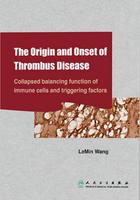
上QQ阅读APP看书,第一时间看更新
Introduction
Thrombosis, in arterial or venous vessels, is a common disease with a high morbidity worldwide. Since all the organs and tissues are supported by the blood circulation system, thrombus can occur in any part of the body and is related to a diverse range of clinical disciplines. Additionally, the presence of arterial or venous thrombosis is indicative of a subversive imbalance in the body defense system.
In 1856, the German pathologist Rudolf Virchow first identified 3 main factors responsible for thrombosis, subsequently known as Virchow's triad, including hypercoagulability of the blood, damage of the vessel wall and hemodynamic alterations such as stasis. Virchow's triad remains the paradigm guiding clinical practice today.For decades, there have been many international guidelines on the prevention, clinic diagnosis and treatment of arterial and venous thrombi, proposing risk factors and risk stratification of arterial or venous thrombus. Thrombosis in the coronary, cerebral,peripheral arteries and pulmonary arteries and in deep vein still remains at a high incidence worldwide, so different interventions and prevention measures have been adopted. Patients with thrombotic diseases may suffer from the sequelae and young patients often die from thrombosis.
The advantages of the refinement of the clinical branches for the convenience of intensive work are self-evident. However, for the specifics of the refinement, the viewpoints of the practitioners are limited: they tend to focus on the divided parts, so the human body integrality is often cut into pieces. As a result, the knowledge is often fragmentary and the internal integrity of science is split, largely owing to the limitation of recognition about the disease, which, whether in the arterial or venous system, is usually a local expression of a systemic disease instead of abnormities in one particular organ or a single vessel branch. Therefore, it should be analyzed in a holistic view rather than at the specif i c thrombotic organ or location to search for the leakage.
For the evidence-based medicine of thrombotic diseases, risk factors could be evaluated based on the observed clinical manifestations. However, they are not the essence of the genesis of the disease and so may not reveal the causality of the disease.Statistical data may suggest the causality but may not be correct. In order to comprehend the thrombosis correctly, the underlying mechanisms should be explored.
Much about thrombosis is still a mystery, such as its origins. A full picture of the thrombosis should be obtained with a holographic thinking instead of the linear or planar thinking. Meanwhile, the mechanisms behind the development of the thrombotic disease should be revealed, and the processes of pathogenesis from the clinical manifestation to the nature of the disease should be explored. There are needs of evidence, epitomization of medical knowledge, integration of multiple disciplines,as well as vertical and horizontal fusions. Not only a deep understanding of the clinical practices should be established to raise query in clinics, but also the advanced methods in modern medicine should be adopted to deal with the massive data acquired. In the meanwhile, rational thinking and hierarchical analysis on a philosophical level are indispensable, which is just like exploring the unknown mysteries of the universe.
Venous thrombosis is triggered by infected cells or malignant cells, while arterial thrombosis may be triggered by pathogenic microorganisms. However, the underlying condition of both venous and arterial thrombosis is the same. Both thrombosis occur under the collapse of the immune cell balance function, which is the common kernel of the origin of thrombus disease. The venous thrombosis results from the substitution of own new defense morphology, but the arterial thrombosis results from the self repair of the injured endarterium. The dif f erent expressing ways both follow common law of biology, which benef i ts self stabilization and continuity of living bodies. However, the local benef i cial defense and repair lead eventually to harmful thrombotic clogging, and the activation of blood coagulation factors only makes the defense and repair firmer.
The immune system, consisting of a variety of organs, tissues, cells and their products, which is to timely and ef f ectively remove deleterious factors from the body.Collapsed immune cell balance function refers to non-function or signif i cant dysfunction of immune cells. There are short-term inhibition of immune cell function and long-term signif i cant dysfunction of immune cell function. Systemic immnune cell balance function collapse inevitably results in subversive disease, including thrombotic diseases. Even in the presence of thrombus risk factors, thrombosis will not occur in an individual with a healthy immune cell balance function.
The nervous, endocrine and immune systems paly important roles in regulating internal physiological activities and self equilibrium as a whole. The neuro-endocrineimmune regulation is a huge development of the macro-control theory of modern medicine. The innate and adaptive immune functions are both under the mediation of the vegetative nerve and endocrine systems. Thus, immune cell balancing function collapse is associated with the state of over stress, in which transmitters secreted by excessively activated sympathetic nerves can decrease the number of lymphocytes,inhibit the receptors of lymphocytes, increase the number of phagocytes, and activate the receptors of phagocytes. This phenomenon is obvious in middle-aged patients with thrombotic diseases. The immune function can be influenced by many factors such as advanced age, infection, temperature, barometric pressure, drugs as well as food balance, with which thrombotic diseases in elder people are often related. It should be extended to the upstream of the disease from the middle and lower reaches to prevent the thrombotic disease, to decrease the incidence and to increase the cure rate. Hence,it is needed to lower the stress level inside human body and restore the balance of neuroendocrine functions, which is the new content of prevention, treatment and rehabilitation of thrombotic diseases.